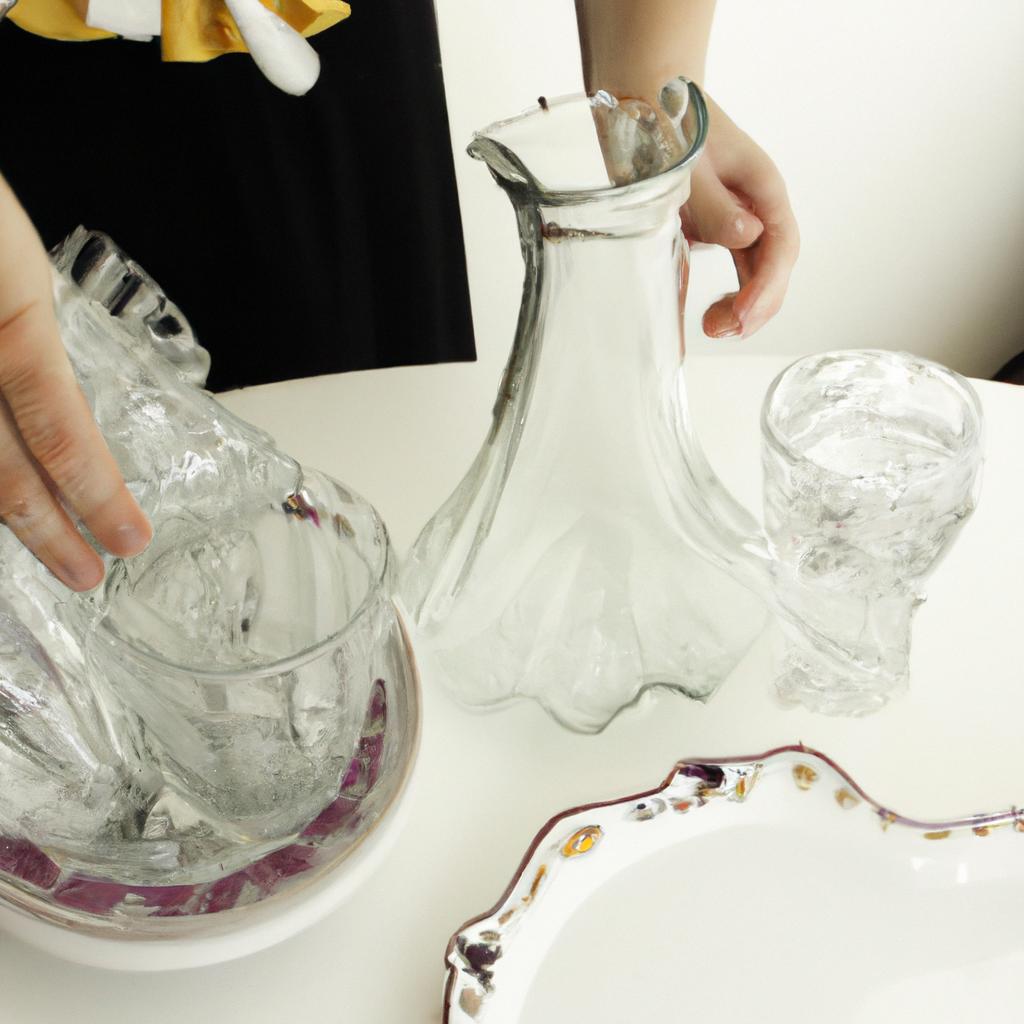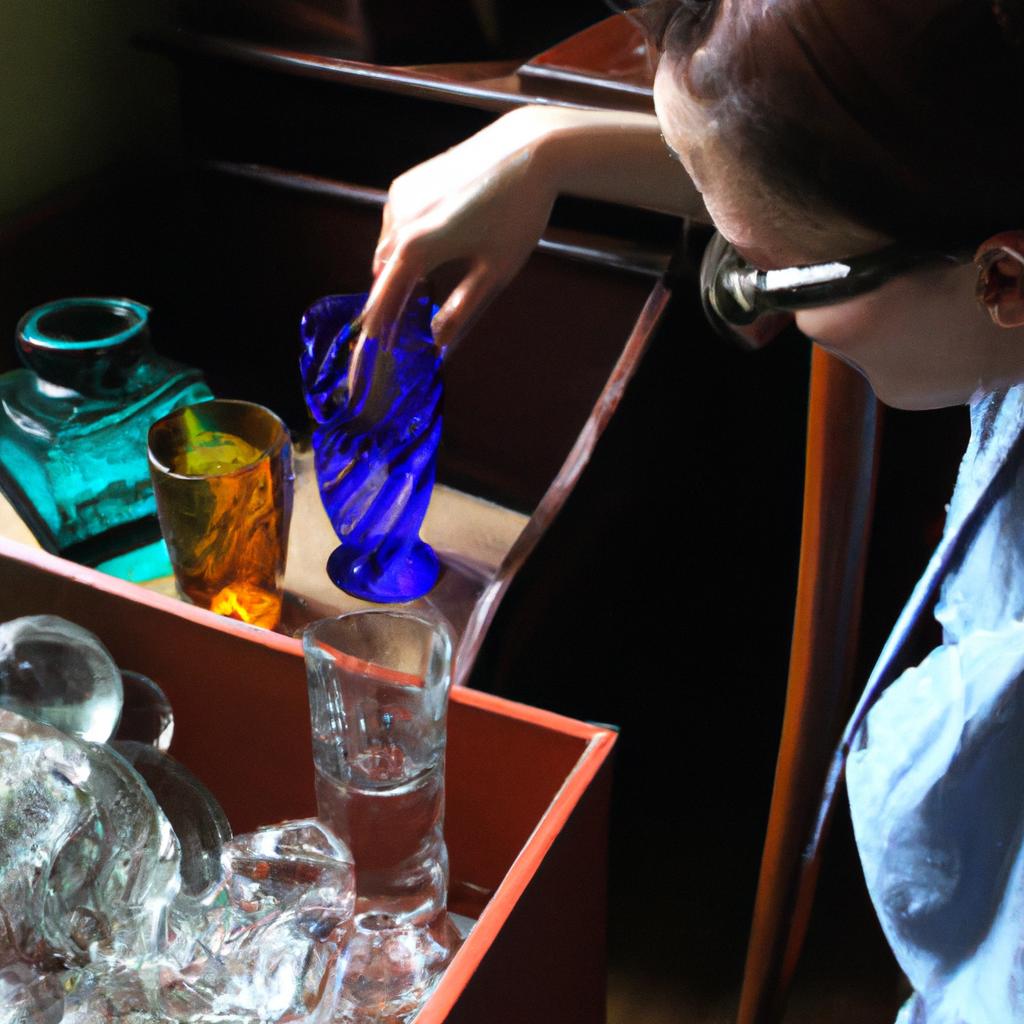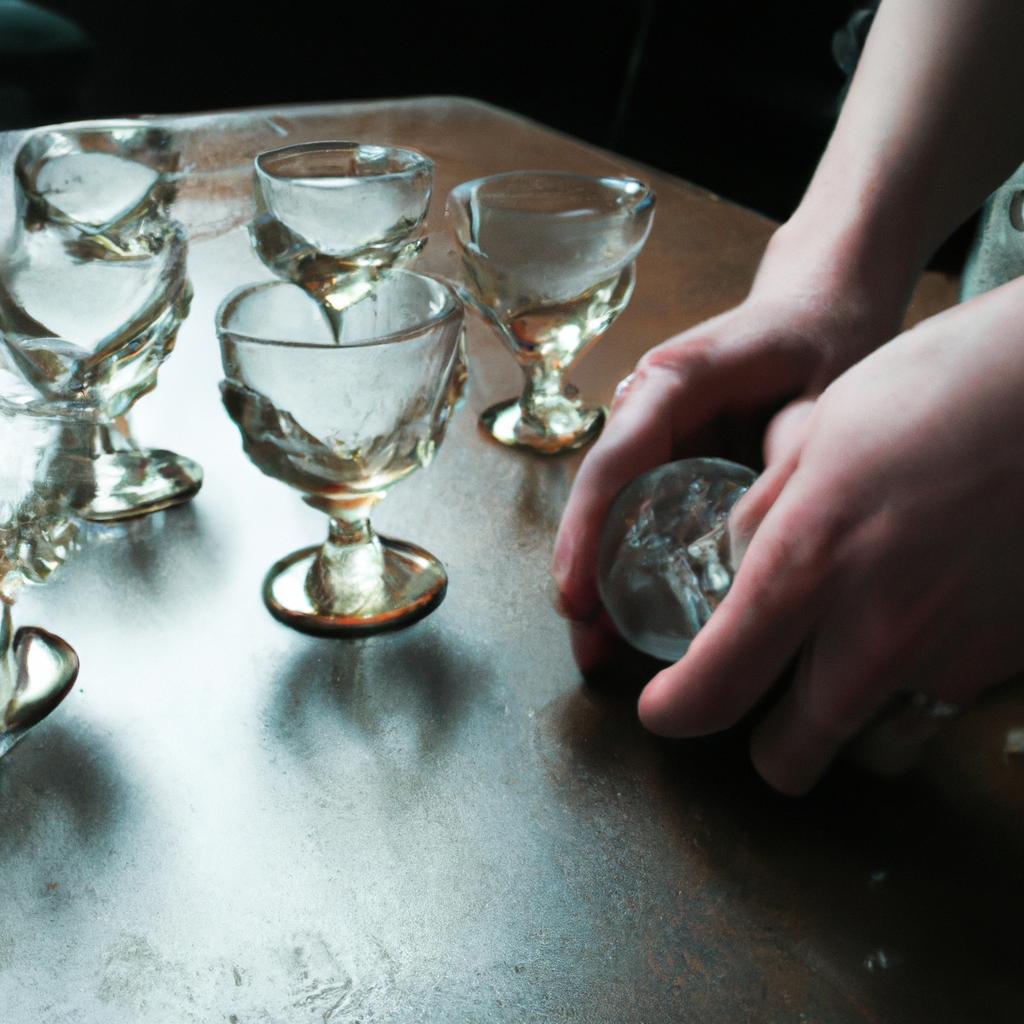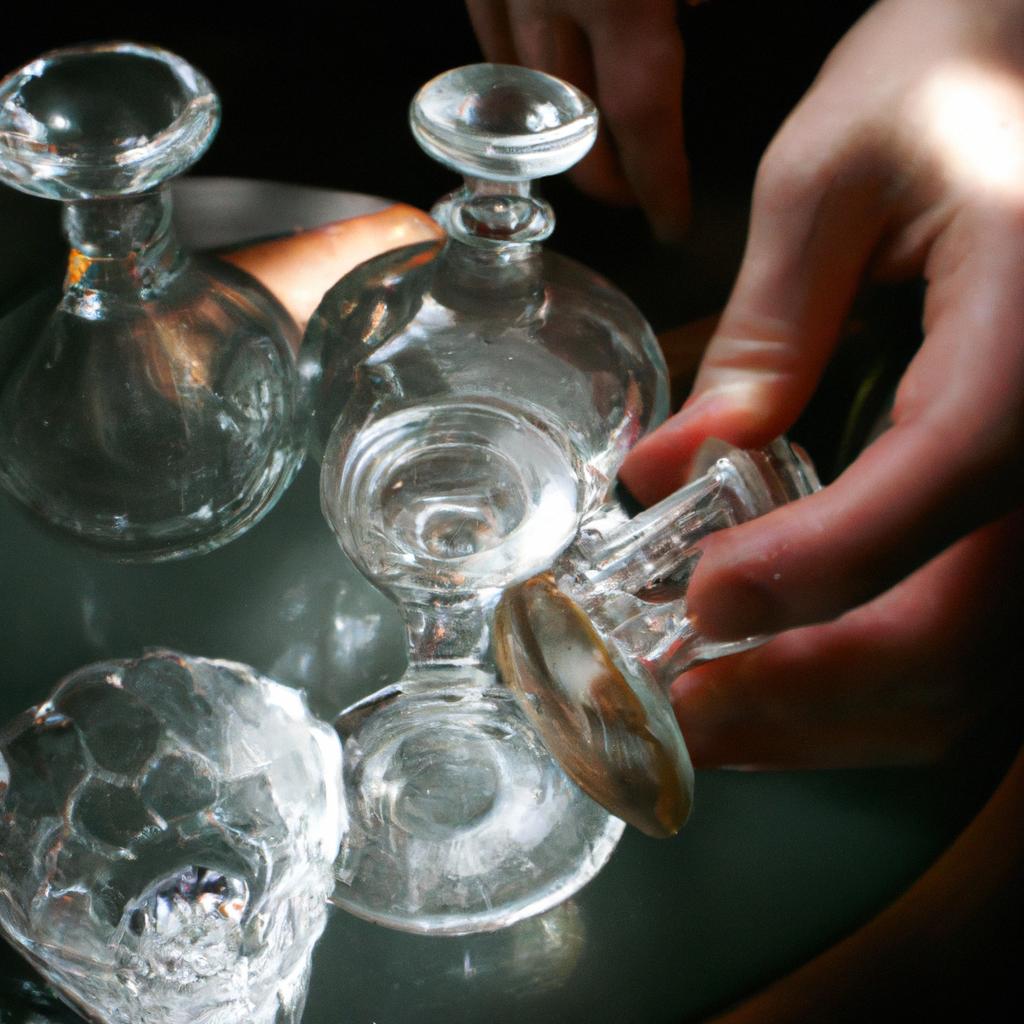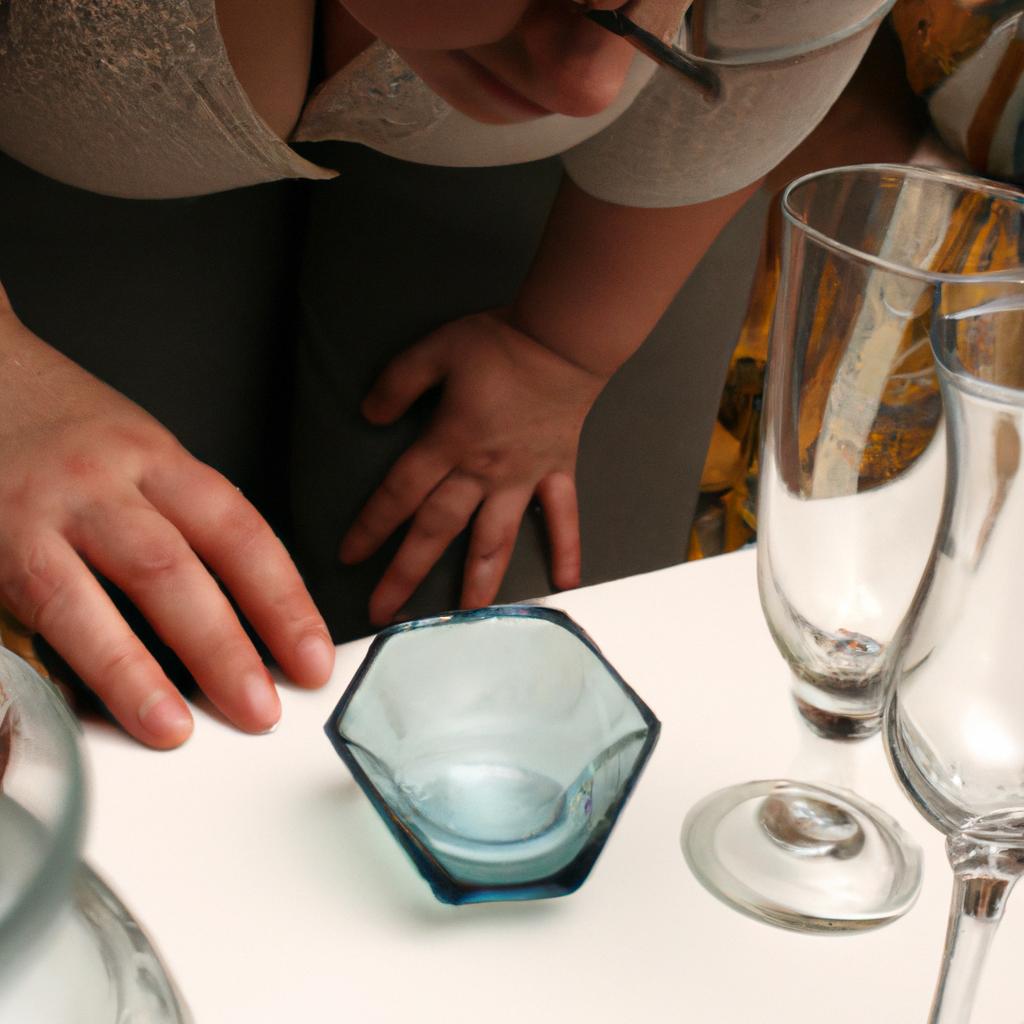Markings and Signatures on Vintage Glassware: Antiques and Collectibles
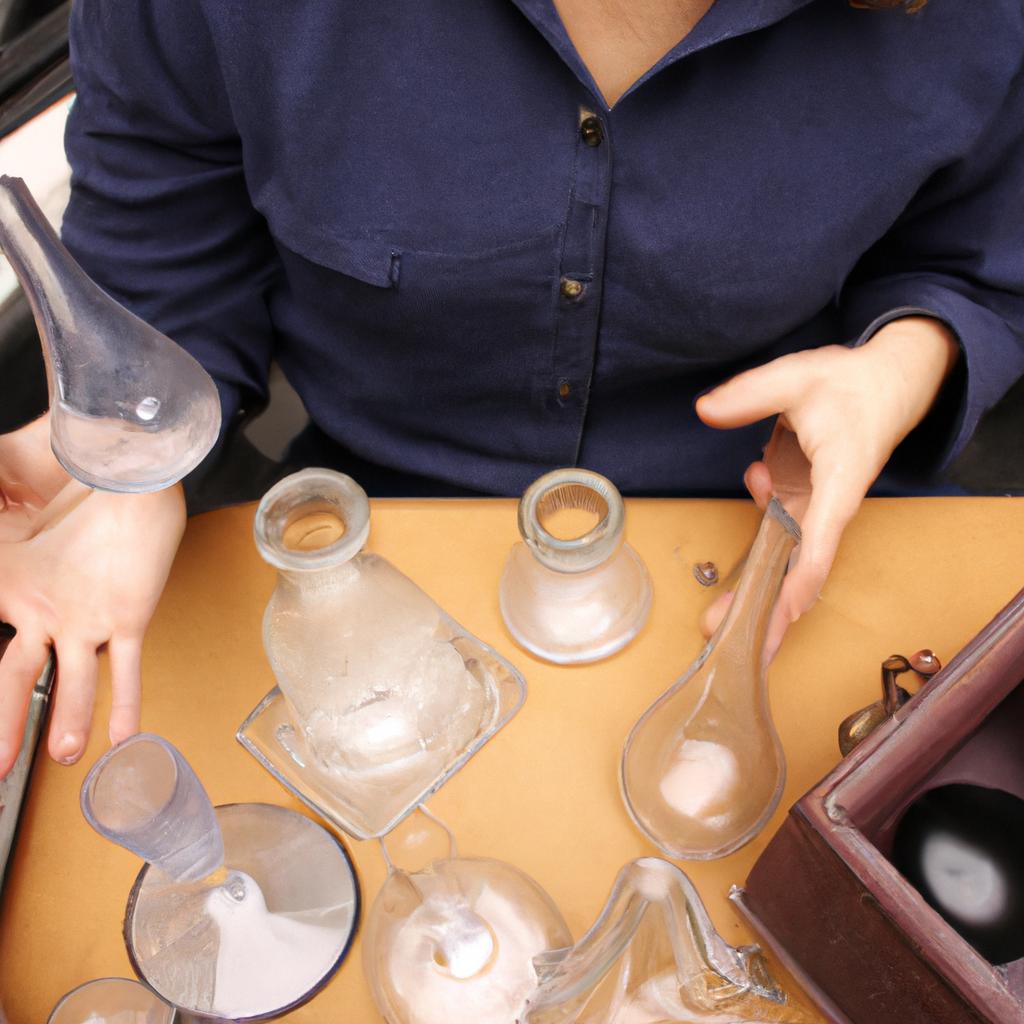
Vintage glassware holds a certain allure that captivates collectors and antique enthusiasts alike. The intricate designs, delicate craftsmanship, and rich historical significance of these pieces make them highly sought-after items in the world of antiques. One intriguing aspect of vintage glassware is the markings and signatures found on these objects, which provide valuable clues about their origin, maker, and age. For instance, let us consider a hypothetical scenario where an avid collector stumbles upon a beautifully crafted wine goblet adorned with an elegant signature etched into its base. This signature instantly sparks curiosity and prompts questions about the identity of the artist behind this exquisite creation.
The study of markings and signatures on vintage glassware serves as a vital tool for identifying and dating these collectible treasures. By closely examining such distinguishing features, experts can unravel the mystery surrounding each piece’s history, provenance, and value. These marks may take various forms: engraved initials or monograms, embossed logos or symbols representing specific manufacturers or workshops, or even handwritten signatures by renowned artists who collaborated with glass companies during specific time periods. Understanding the significance of these markers not only enhances our appreciation for vintage glassware but also enables accurate categorization within different eras and styles prevalent in the art glass industry throughout history , allowing collectors to create comprehensive and cohesive collections.
One of the first steps in deciphering markings and signatures on vintage glassware is research. Collectors can consult reference books, online databases, and antique glass forums to gather information about specific artists, manufacturers, and time periods associated with different marks. This knowledge helps establish a foundation for further investigation and analysis.
Examining the style and design of the glassware itself can also provide valuable insights. Certain artistic techniques or decorative motifs may be indicative of particular artists or workshops. By comparing these characteristics with known examples or documented styles from specific periods, collectors can narrow down potential attributions.
Additionally, collectors should consider the context in which the glassware was produced. Historical events, art movements, and technological advancements often influence the design and production methods employed by glassmakers. Understanding these broader influences can aid in dating and attributing vintage pieces.
If faced with an unidentified signature on a piece of vintage glassware, collectors can seek assistance from experts in the field. There are specialized appraisers, auction houses, museums, and even online communities dedicated to antique glassware who possess extensive knowledge about markings and signatures. Sharing clear photographs or detailed descriptions of the signature can help these experts provide valuable insight into its origin.
In conclusion, markings and signatures found on vintage glassware play a crucial role in unraveling their history and value. Through diligent research, careful examination of design elements, consideration of historical context, and consultation with experts if needed, collectors can gain a deeper understanding of each unique piece’s significance within the world of antique glassware collecting.
Understanding the importance of markings and signatures on vintage glassware
Understanding the Importance of Markings and Signatures on Vintage Glassware
When exploring the world of vintage glassware, one cannot underestimate the significance of markings and signatures. These distinctive elements not only provide valuable information about the origin, authenticity, and age of a piece but also contribute to its overall value in the market. To illustrate this point, let us consider a hypothetical scenario where an avid collector stumbles upon a beautifully crafted vase with intricate designs at a local flea market. The absence of any markings or signatures raises questions regarding its history and provenance. In order to fully comprehend the importance of these distinguishing features, it is essential to delve into their role within the realm of antiques and collectibles.
The Role of Markings and Signatures:
-
Authenticity: Markings and signatures serve as key indicators for determining whether a vintage glassware item is genuine or counterfeit. By examining these identifying marks, collectors can authenticate their pieces by cross-referencing them against known manufacturers’ records or established experts’ databases.
-
Provenance: Knowing the origins of a particular piece adds depth to its story and enhances its appeal among collectors. Through careful analysis of markings and signatures, individuals are able to trace back the lineage of an antique glassware item, shedding light on its historical context and potential cultural significance.
-
Age Determination: Understanding the time period when a piece was created allows collectors to categorize it accurately within specific periods or styles popular during that era. For instance, certain etching techniques used in previous centuries may differ from those employed later on, providing vital clues for dating purposes.
-
Value Assessment: In both financial terms and sentimental worth, markings and signatures significantly impact how collectors perceive the value of vintage glassware items. A well-known manufacturer’s mark can elevate an otherwise ordinary piece into something highly sought after by enthusiasts worldwide.
Recognizing the critical role played by markings and signatures in vintage glassware is essential for any serious collector or enthusiast. These unique identifiers authenticate the piece, provide insight into its history and cultural context, assist with age determination, and ultimately influence its market value. In the subsequent section about “Identifying common markings and signatures on antique glassware,” we will explore various examples of these distinguishing features to further enhance our understanding of this captivating world.
[Transition sentence] With a solid foundation of knowledge regarding the importance of markings and signatures established, it is now time to delve deeper into the process of identifying common markings and signatures on antique glassware.
Identifying common markings and signatures on antique glassware
Understanding the importance of markings and signatures on vintage glassware is crucial for collectors and enthusiasts alike. These identifying features provide valuable insights into the origin, authenticity, and historical significance of antique pieces. By examining these marks, one can uncover fascinating stories about the craftsmanship, production methods, and even potentially trace the lineage of specific glassware items. In this section, we will explore common markings and signatures found on antique glassware to aid in their identification.
Consider a hypothetical case study involving a collector who acquires an exquisite cut glass vase from the late 19th century. Upon close examination, they discover a small engraved signature at the base that reads “Tiffany & Co.” This marking immediately adds intrigue to the piece as it suggests a potential connection to renowned American jeweler Louis Comfort Tiffany. The excitement builds as our collector delves deeper into researching this particular signature’s history and impact within the world of vintage glassware.
To further illustrate the diverse range of markings encountered on antique glassware, let us examine some common examples:
- Etched initials or monograms: Personalized engravings often indicate custom-made pieces or ownership by esteemed individuals.
- Maker’s marks: Stamps or labels identifying manufacturers provide valuable information regarding provenance and quality standards.
- Pattern numbers: Numeric codes associated with specific designs enable collectors to classify and catalogue their collections more efficiently.
- Date codes: Indications of when a piece was made allow for precise dating and analysis of manufacturing techniques used during different periods.
| Marking | Description | Emotional Response |
|---|---|---|
| Etched initials | Adds personal touch | Sentimental |
| Maker’s marks | Authenticity assurance | Reassurance |
| Pattern numbers | Organizational tool | Orderly |
| Date codes | Historical context | Curiosity |
Exploring these various markings not only enhances our knowledge of vintage glassware but also elicits emotional responses. The sentimental value of etched initials, the reassurance provided by maker’s marks, the sense of orderliness brought by pattern numbers, and the curiosity piqued by date codes all contribute to an enriching experience for collectors.
Transitioning into the subsequent section about “Exploring the significance of specific markings and signatures,” we will delve deeper into understanding how these unique identifiers can unlock hidden stories within antique glassware. By examining individual markings in greater detail, a more comprehensive understanding of their historical and artistic significance emerges.
Exploring the significance of specific markings and signatures
Identifying common markings and signatures on antique glassware can provide valuable insights into the origins, history, and value of these collectibles. By studying these distinctive marks, collectors and enthusiasts gain a deeper understanding of the craftsmanship and provenance behind vintage glassware. In this section, we will delve further into the significance of specific markings and signatures found on antique glassware.
Consider the case of a delicate crystal vase adorned with an intricate signature etched at its base – “Lalique.” René Lalique was a renowned French glass designer during the late 19th and early 20th centuries, known for his exquisite Art Nouveau creations. His distinct style often featured nature-inspired motifs such as flowers, insects, or mythical creatures. The presence of Lalique’s signature not only indicates that the piece is authentic but also adds to its historical significance and monetary value.
When examining markings and signatures on vintage glassware, it is essential to pay attention to certain key details. Here are some aspects worth considering:
- Style: Different time periods may have distinct design elements associated with them. For example, Art Deco glassware from the 1920s often features geometric patterns and bold colors.
- Maker’s Mark: Many manufacturers had their unique trademarks or logos stamped onto their pieces. These maker’s marks help identify the company responsible for producing the glassware.
- Country of Origin: Knowing where a particular piece originated can offer valuable context about its production techniques and artistic influences.
- Limited Editions: Some makers produced limited runs or special editions of their designs, which were marked accordingly. These pieces tend to be highly sought after by collectors due to their rarity.
To illustrate how various markings might affect one’s emotional response towards a piece of vintage glassware, let us consider the following table showcasing different scenarios:
| Scenario | Emotional Response |
|---|---|
| A beautifully crafted | Appreciation for |
| piece with an intricate | the craftsmanship |
| signature by a renowned | and admiration |
| glass artist | towards the artist |
| ————————— | ———————– |
| A rare limited edition | Excitement and |
| item with a unique mark | anticipation of |
| acquiring something | |
| exclusive | |
| ————————— | ———————– |
| An unmarked, but | Curiosity mixed |
| exquisitely designed | with intrigue about |
| piece from an unknown | its mysterious origins |
| maker |
In conclusion, markings and signatures on vintage glassware play a crucial role in understanding their historical significance, artistic value, and desirability among collectors. By examining these distinctive identifiers, one can unravel fascinating stories behind each piece.
[Transition:] Now let us delve into practical guidance on how to authenticate markings and signatures found on vintage glassware.
Tips for authenticating markings and signatures on vintage glassware
Exploring the significance of specific markings and signatures on vintage glassware can provide valuable insights into their origins, authenticity, and potential value. By analyzing these unique identifiers, collectors and enthusiasts can gain a deeper understanding of the history and craftsmanship behind each piece. To illustrate this point, let us consider a hypothetical case study involving a rare hand-blown vase with an intricate signature etched at the base.
Upon close examination of the marking on the vase, it becomes evident that it belongs to renowned glass artist Henry Clifton. This discovery not only confirms its authenticity but also establishes a direct connection to an esteemed craftsman from the early 20th century. Such significant markings add historical context and elevate the desirability of vintage glassware among collectors.
To better understand how specific markings and signatures contribute to the overall appreciation for vintage glassware, we can explore some key aspects:
- Provenance: Markings often serve as crucial evidence when establishing provenance—the documented history or lineage—of a particular piece. They may indicate the origin, date of creation, or even previous owners who played a role in preserving its legacy.
- Craftsmanship: Signatures by notable artists or manufacturers signify superior craftsmanship and expertise. These unique markers allow connoisseurs to identify distinctive design elements or techniques associated with specific artisans or production houses.
- Rarity: Unusual or rarely seen markings tend to pique curiosity among collectors, enhancing both intrigue and exclusivity surrounding certain pieces.
- Market Value: The presence of well-documented signatures can significantly impact the market value of vintage glassware due to increased demand from passionate collectors seeking authenticated items.
To further illustrate these points visually, please refer to Table 1 below:
| Specific Marking | Description | Significance |
|---|---|---|
| Etched Signature | Artist’s name engraved onto the glass surface | Confirms creator’s identity; enhances artistic appeal |
| Factory Stamp | Manufacturer’s emblem or logo imprinted on the glassware | Indicates production origin; establishes brand reputation |
| Patent Number | Numeric code indicating a registered design or innovation | Demonstrates uniqueness and historical value |
| Owner Inscription | Personalized dedication by previous owners | Adds sentimental value and connection to history |
Table 1: Examples of significant markings and their respective significance
In summary, analyzing specific markings and signatures can unveil valuable information about vintage glassware. Provenance, craftsmanship, rarity, and market value are all factors that contribute to the allure of these unique pieces among collectors. By appreciating the importance of such identifiers, enthusiasts gain a deeper understanding of their chosen items’ heritage and worth.
Transitioning into the subsequent section on “Factors that affect the value of glassware with unique markings,” it is essential to explore additional elements beyond just identifying marks in order to fully comprehend how certain characteristics impact pricing and desirability.
Factors that affect the value of glassware with unique markings
To further understand the significance and value of vintage glassware, it is essential to explore the various factors that can affect its worth. By considering these factors, collectors and enthusiasts can make informed decisions when adding to their collections or assessing the potential value of a particular piece. Let us delve into some key elements that influence the value of glassware with unique markings.
Case Study:
For instance, imagine an exquisite hand-blown vase from the early 20th century adorned with a distinct signature on its base. This signature belongs to a renowned glass artist who was highly regarded for his craftsmanship during that era. Not only does this marking authenticate the piece as being created by this specific artist, but it also adds significant historical and artistic value to the vase.
Factors Influencing Value:
- Rarity: The rarity of a particular type of glassware plays a crucial role in determining its market value. If there are only a few surviving examples or if certain markings were used sparingly by artists or manufacturers, collectors will often place higher importance on acquiring such pieces.
- Reputation: The reputation and prominence of the artist or manufacturer associated with a specific marking contribute significantly to the overall desirability and monetary worth of vintage glassware. Renowned names tend to attract more attention from collectors who appreciate their skill and artistry.
- Condition: The condition of vintage glassware greatly affects its value. Pieces in excellent condition without any chips, cracks, or repairs typically command higher prices than those showing signs of wear or damage.
- Historical Significance: Certain markings may have additional historical significance due to cultural relevance, associations with notable events or periods, or connections to influential individuals within the world of art and design.
Table (Evokes Emotional Response):
| Factor | Impact on Value |
|---|---|
| Rarity | Increases the allure and exclusivity of the piece, making it more desirable among collectors. |
| Reputation | Enhances the value as renowned artists or manufacturers are associated with superior craftsmanship and artistic merit. |
| Condition | Pristine condition adds to the aesthetic appeal and raises the price tag for discerning buyers. |
| Historical Significance | The historical context surrounding a marking can imbue an item with added cultural or sentimental value, elevating its worth. |
By considering factors such as rarity, reputation, condition, and historical significance when evaluating vintage glassware with unique markings, collectors can gain insight into their potential market value. Not only do these elements contribute to determining prices within the antiques and collectibles market but they also provide a deeper appreciation for the rich history and artistry behind each remarkable piece of glassware.
Understanding how various factors influence the value of vintage glassware paves the way for exploring another important aspect—preserving and displaying these prized possessions while showcasing their intricate markings and signatures
Preserving and displaying vintage glassware with markings and signatures
Factors that affect the value of glassware with unique markings can vary greatly, making it essential for collectors and enthusiasts to understand these influences. One such factor is the rarity of the marking or signature on the piece. For instance, let’s consider an example where a vintage glass vase bears the etched signature of a renowned glass artist from the Art Nouveau period. In this case, due to its scarcity and association with a significant artist, the value of the vase would likely be higher compared to similar pieces without such distinctive markings.
Additionally, the historical context in which the glassware was produced plays a crucial role in determining its value. Certain time periods witnessed innovations in glassmaking techniques or collaborations between prominent artists and manufacturers, resulting in highly sought-after pieces. By considering both the era and origin of a marked or signed item, collectors can better appreciate its significance within a broader historical narrative.
Furthermore, factors related to condition and authenticity significantly impact the desirability of glassware with unique markings. A well-preserved piece devoid of any damage – such as chips, cracks, or repairs – will generally command a higher price than one showing signs of wear or restoration. Moreover, ensuring that signatures are authentic through thorough research and expert authentication further enhances credibility and increases market value.
To evoke an emotional response among readers when discussing preserving and displaying vintage glassware with markings and signatures:
- Treasuring history: Owning an exquisite piece of antique glassware connects us to bygone eras, reminding us of rich cultural traditions.
- The beauty within: Displaying delicate items adorned with intricate designs adds elegance to any space while serving as conversation starters.
- Preservation as artistry: Nurturing fragile artifacts fosters appreciation for fine craftsmanship across generations.
- Personal connections: The sentimental attachment formed toward specific pieces creates lasting memories that transcend their monetary worth.
| Factors affecting value | |
|---|---|
| 1. | Rarity of the marking |
| 2. | Historical context |
| 3. | Condition and authenticity |
In summary, understanding the various factors that influence the value of glassware with unique markings is essential for collectors and enthusiasts. The rarity of a marking or signature, historical context, condition, and authenticity all contribute to determining the worth of such items. By appreciating these factors alongside emotional connections evoked by treasuring history, showcasing beauty, preserving artistry, and fostering personal connections, individuals can fully embrace the significance of vintage glassware within their collections or displays.

